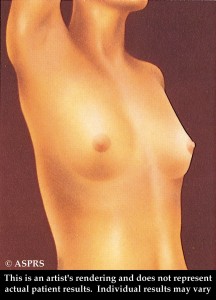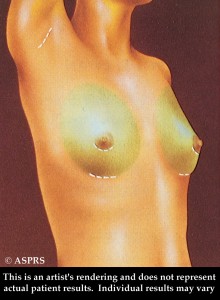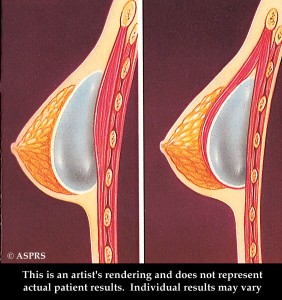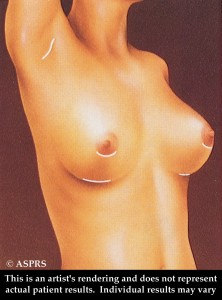INTRODUCTION
Current techniques involved in augmenting the breast require the use of a breast prosthesis filled with saline solution, silicone gel or cohesive gel. To augment the breast, the prosthesis can be placed either behind or on top of the pectoral muscles. It can be placed through an inframammary incision (the lower breast crease), a nipple/areola incision or an incision in the axilla (armpit region). You surgeon will advise you what is best for you.
It should be understood that every patient is unique. The quality of skin, the body height, the shoulder width, the size of the breast and the size and shape of chest wall are all to be considered when evaluating the patient. These elements vary from patient to patient which is why your friend may be offered surgery different than yours, especially in terms of size of implant. This also applies to wanting what is seen in a magazine or on a web site. Be realistic in your expectations and open with your surgeon. Keep in mind that the best results are obtained when augmenting what already exists rather than trying to create what is not there. If a small patient wishes for the placement of enormous implants, there may not be enough space to accommodate them or they may end up being obviously fake-looking.
Probably the most difficult aspect for the patient is to determine the size of implant she wishes. The unknown is always understandably anxiety-provoking and this is no different. Your surgeon can give you advice regarding the appropriate size of implant to consider and this can be used as a starting point for you. An easy method to determine the desired implant size is the following:
- ” Buy a bra that you would like to wear after breast augmentation. Ensure that it has an underwire and made of expandable material such as cotton.
- Get a measuring cup and measure out 250ml of rice
- Separate the rice into 3 separate baggies (the kind without the Ziploc)
- Wear the bra that you purchased and fill one side with all three bags, making sure to fill the side, underneath and top of the breast
- Do the same for the other side.
- If you find the amount too small, take out one bag, add or remove 30ml-60ml of rice and reposition the bag. Do the same for the other side. Continue doing this until you feel it is the size that you desire
- Empty the bags from one side into the measuring cup and measure the amount of rice that you used to fill one side. This should roughly correspond to the size of implant that you wish since implants are ordered with volumes in millilitres.
You should communicate this measured amount to your surgeon and he should be able to tell you if it is realistic or not. If it is not, a compromise may be achieved after some discussion.
The risk of breast cancer is not elevated in women who have breast implants when compared with those who do not. Mammograms can be taken with implants, although you should advise your radiologist regarding this since he may want to make certain adjustments to the radiograph and also minimize compression of the implants.
Breast-feeding should not be affected if placed though an inframammary or axillary approach. There may be a theoretical disruption of milk-ducts if a trans-nipple approach is used.
AM I A CANDIDATE FOR THIS SURGERY?
An important aspect of every woman is her breasts. They represent both maternal and sexual sides of a woman. Women who find their breasts inadequate often have less confidant personalities. Some women never develop their breasts to their liking, others lament for the breasts they had before pregnancy, an event that can cause the breasts to feel loose and empty. Should you wish to consider this surgery, do it for yourself and not for anyone else and certainly not to follow the latest craze.
PROCEDURE
The surgery can be done under general anaesthesia or with sedation. Pain after surgery can vary from lasting 2 to 3 days if placed above the muscle to 2 to 3 weeks when placed underneath the muscle. Your surgeon will advise to the appropriate amount of time to take off work depending on the surgical approach and your type of work.
Should saline implants be used, they are generally placed underneath the muscle. Silicone gel and cohesive gel prostheses can be placed above the muscle. This is actually the ideal location to augment the breast, especially when the breasts are loose and baggy.
In our clinic, we use Inamed/McGhan implants. We find they provide excellent service and superb warranties on their products.
PREPARATION BEFORE SURGERY
Aspirin and all anti-inflammatory medication should not be taken for three weeks before surgery until two weeks after surgery. Anti-inflammatory medication and Aspirin causes thinning of the blood and may lead to excess bleeding during and after surgery. Tylenol (Acetaminophen), however, does not cause this problem and may be taken.
Alcohol in any form is not to be consumed for two weeks before surgery until two weeks after surgery. Alcohol has properties that dilate blood vessels and thin the blood that can contribute to excessive bleeding during and after surgery. Even a small amount can cause problems.
Should you have regular medications to take, ask your surgeon if you should take them before surgery or not. Certain medications can cause problems and only your surgeon can determine this.
AFTER SURGERY
You will have a dressing, which will be removed, by your surgeon 3 or 4 days after surgery. He may require you to wear a bra for 3 weeks day and night after surgery, only to be removed for showers.
Excessive physical activities should avoided, especially those that require the use of your arms. Excess activity can lead to implant displacement, swelling or bleeding after surgery. You should be able to progressively return to normal activities after about 3 weeks and by 6 weeks all activities can be normalised.
Avoid breast manipulation for 3 weeks.
POSSIBLE COMPLICATIONS
Possible Complications
CONCLUSION
Breast augmentation is a very popular intervention with a high degree of immediate patient satisfaction. With this surgery, it is possible for women to regain the femininity and confidence that she finds inadequate.
FAQ Regarding Breast Surgery
After pregnancy, my breasts have changed. What surgery do I need to give me back what I had?
This is a very good question, but with different possible answers depending on what your physical exam shows. Pregnancy and breast-feeding can often result in a ‘deflated’ breast, which can be demoralizing.
- If the nipple-areola region is pointing toward your toes when you stand up, then it is probable that you need a mastopexy (aka ‘breast-lift’).
- If the nipple region points more-or-less in a forward direction, then you could get away with only a breast augmentation.
- Other times, you may need both a mastopexy and a breast lift, but it all depends on what is found during the physical exam.
I am confused about all the different breast implants out there. Can you clarify this for me?
There are essentially 3 general categories of breast implants: saline-filled implants, silicone-gel implants and cohesive-gel implants. All 3 are made of silicone, a substance which can be made liquid (like molasses), semi-solid (like a gummy bear) or quite hard (like a car tire).
Saline-filled implants are essentially a hard silicone rubber balloon that is filled with saline solution during the surgery. Because the saline solution can easily create waves with motion, these implants are placed behind the muscle so that the waves and ripples are less visible. Also, since this is essentially a balloon, the implants can leak and deflate.
Silicone-gel implants are made of a silicone rubber shell pre-filled with a more liquid silicone. These implants do not produce waves or ripples as much as saline, and can be placed either above or behind the muscle. They can, however, leak and the liquid silicone can spread outside the confines of the implant when this happens. They also are more prone to forming implant capsules.
Cohesive-gel implants are made of a rubbery silicone exterior shell filled with a slightly less rubbery silicone interior, somewhat resembling a Gummy Bear in consistency. Because of this property, they do not leak, but they have to be pre-shaped during production. They can also be placed above or below the muscle since there is very little rippling. They are technically more challenging to use since the surgeon needs to have a good eye to choose the right implant for each patient. The results, however, are the most natural. Dr Hashim has extensive experience with anatomic implants and he is an internationally recognized expert in their use.
My friend told me that implants are better under the muscle. Is this true?
No. Your breasts sit on top of the muscle, so the most natural result is to have an implant above the muscle. There is no inherent beauty in placing an implant underneath the muscle and the only reason to place them in this position is to hide the limitations of the implant. For example, a saline-filled implant may show waves and rippling through the skin if they are placed on top of the muscle. If someone is very thin, then the implant may show too much. It also depends on the type of implant. Silicone-filled implants are more prone to noticeable capsule formation on top of the muscle, so it may be better underneath. However, cohesive-gel implants that are anatomic in shape look very good on top of the muscle and it is the preferred position by Dr Hashim.
You should be aware that implants that are placed underneath the muscle may get displaced with muscle contraction, so if you are very physically active, you should seek a surgeon who is able to use anatomic cohesive-gel implants on top of the muscle.
Can I have a breast-lift and augmentation at the same time?
Dr Hashim prefers to separate these surgeries to get the best result possible and perhaps save you some time and money! During your consultation with him, Dr Hashim will determine which surgery is best to start with.
Often, the treatment starts with a breast augmentation and depending on the state of your breasts, it may be enough, and not require a second stage breast-lift, which would save you time, money and scars! We estimate that 90% of patients do not need to go on to a breast lift after an augmentation.
Similarly, he may start with a breast-lift and see if a second stage augmentation is required or not. This would depend on the actually mass of breast tissue available during the lift.
Can I have breast surgery at the same time as a tummy-tuck?
Absolutely!
Do I need to change my breast implants after a certain period?
There is no ‘expiry date’ when you have to exchange implants. Implants are exchanged only when needed, such as a leaky implant or a bothersome capsule that has formed around the implant. Saline implants generally last at least 10 years, and cohesive-gel implants can last much longer.




